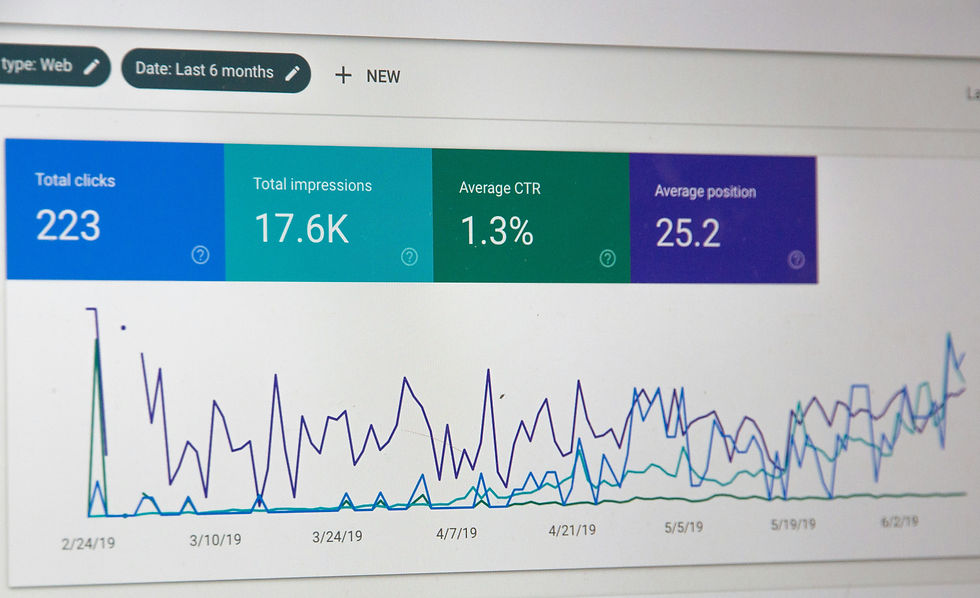How to Boost Your SEO with Keyword Planning
- Liz Achanta

- Feb 10
- 4 min read
I was recently on a call where we were trying to see who our top competitors were for a new product the company launched last year. When I typed in the phrase, 'buy <product keyword here>,' big surprise: we found all of our competitors, but our company - despite the thousands of dollars invested into SEM and Paid Search - was nowhere to be found in that first listing page.

It's common knowledge now that if your product isn't listed in the first page of a Google search, your doing something wrong (or you're in an advertising bidding war against high spenders). Especially now, when in 2024 it was reported that nearly 60% of Google searches resulted in 0-clicks: as in the searcher found the information they needed without even going to a website (thanks AI).
If you're a small business owner, you already know how critical it is to appear in search results. Whether you run a boutique, a local coffee shop, or a hair salon in Detroit, strong SEO (Search Engine Optimization) can help you attract more customers. One of the most effective ways to improve your SEO is through keyword planning.
Since I was already doing this exercise for the product I mentioned before, I've decided to make a guide on my process for walking through the essentials of keyword research, including free tools you can use and a step-by-step approach to finding the right keywords for your business. I'll use a Detroit-based hair salon as myexample to illustrate how to apply these strategies effectively.
What is Keyword Planning?
Keyword planning is the process of researching and selecting words or phrases that potential customers are searching for online. These keywords help search engines like Google understand what your business is about so they can direct relevant traffic to your website.
Effective keyword planning helps you:
Rank higher in search results
Increase website traffic
Attract the right audience
Improve conversion rates
Free Keyword Research Tools
You don’t need to invest in expensive software to start your keyword research. Here are some free tools that can help:
Part of Google Ads, this tool helps you find keyword ideas and see estimated search volumes.
How to use it: Enter a keyword related to your business, and it will suggest related terms along with their search volumes.
2. Google Search Autocomplete & Related Searches
Simply start typing a phrase into Google, and it will suggest searches based on what people frequently look for.
At the bottom of search results, you’ll also find “Related searches” with additional keyword ideas.
3. Ubersuggest
Neil Patel's free tool that provides keyword ideas, search volume, and SEO difficulty scores.
Ideal for beginners as it provides easy-to-understand data.
Generates questions and phrases that people are asking about a specific topic.
Great for finding long-tail keywords (phrases with three or more words that target specific searches).
Helps you track keyword popularity over time and compare search interest between terms.
Useful for identifying seasonal trends in your industry.
How to Do Keyword Research: Step-by-Step
Now that you have the tools, let’s go through the process of keyword research using a Detroit-based hair salon as an example.
Step 1: Identify Your Core Services
Think about what your business offers. For a hair salon, the main services might be:
Haircuts
Hair coloring
Extensions
Bridal hair
Blowouts
These core services will help you generate relevant keyword ideas.
Step 2: Find Keyword Variations
Using Google Keyword Planner, Ubersuggest, and Google Search, look for keyword variations that potential clients might use.
For example, instead of just "haircuts," consider:
"women’s haircuts in Detroit"
"best salon for men’s haircuts Detroit"
"Detroit hair salons for curly hair"
Step 3: Look for Long-Tail Keywords
Long-tail keywords tend to have lower competition and can attract highly targeted customers.
Examples:
"Where to get balayage in Detroit"
"Best affordable hair salon in Midtown Detroit"
"Wedding hair and makeup Detroit MI"
Step 4: Analyze Search Intent
Understanding why people search for certain terms is crucial. Keywords generally fall into these categories:
Informational: "How to maintain colored hair"
Navigational: "Hair salons near me"
Transactional: "Book a haircut in Detroit"
For a hair salon, you’ll want to focus on transactional and navigational keywords since they drive customer action.
Step 5: Check Competitor Keywords
Use tools like Ubersuggest to analyze competitors' websites and see what keywords they are ranking for. If a competing salon is ranking well for "best balayage in Detroit," you might want to optimize your site for that term too.
Step 6: Implement Keywords on Your Website
Once you've identified the right keywords, use them strategically:
Homepage: Include primary keywords in the page title, meta description, and headings.
Service Pages: Optimize each service page with relevant keywords.
Blog Posts: Write articles around long-tail keywords (e.g., "How to choose the best hair color for your skin tone").
Image Alt Text: Add keywords to image descriptions to help with search visibility.
Step 7: Track and Adjust
SEO is an ongoing process. Use Google Search Console and Google Analytics to track which keywords are driving traffic and adjust your strategy accordingly.
Keyword planning is a powerful tool that can help your small business rank higher on Google and attract more customers. By using free tools and following a strategic research process, you can optimize your website to bring in more traffic and bookings.
For a Detroit-based hair salon, focusing on local SEO, long-tail keywords, and search intent can make a huge difference. Start implementing these strategies today and watch your online presence grow!


